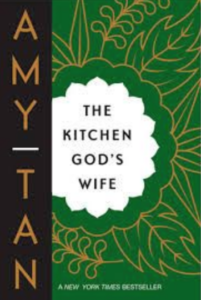The Kitchen God’s Wife by Amy Tan
by Olivia Conway, online editor
I was first introduced to Amy Tan’s writing in tenth grade pre-AP English II when we read The Joy Luck Club. I remember being immediately taken with her prose. The story was engaging and vivid, the characters were real and relatable, and the themes transcend the boundaries of time, geographical area, class, and race. Having loved The Joy Luck Club so much, I was a bit apprehensive to attempt another of Tan’s novels in fear that it would not live up to the beauty and brilliance of The Joy Luck Club. Thankfully, The Kitchen God’s Wife proved to be another example of Tan’s masterful storytelling, a well-written tale of loss, friendship, hope, and the complex bond between mother and daughter. Like The Joy Luck Club, The Kitchen God’s Wife centers on the relationship between a mother and her daughter and the initial differences between them. The daughter, Pearl, fails to completely understand and appreciate her mother, Winnie, and the sacrifices that Winnie made to leave China in the aftermath of World War II in order to give Pearl and herself a chance at a better life in the United States. Both Winnie and Pearl are revealed to be keeping important secrets from each other: Pearl is neglecting to tell her mother about her diagnosis with multiple sclerosis and Winnie has for years abstained from telling Pearl that her father was not actually her biological parent. After insistent prodding from Winnie’s best friend Helen, Pearl and Winnie decide to finally be truthful with each other.
The majority of the book is told from Winnie’s perspective as she recounts her life in China to Pearl. She begins with the initial trauma of her mother unexpectedly disappearing and her time living with her cousin Peanut and her aunts, where she was treated relatively well. It is during this time period of living with her aunts that she meets her first husband, Wen Fu, who is at first presented as charismatic and wealthy, but later turns out to be manipulative, cruel, and abusive. Soon after Winnie married Wen Fu, Wen Fu joined the Chinese air force and the two moved to a military base in China, where Winnie befriended Helen and her first husband. The couples remained close and continued to travel and live together as the war intensified and people fled inland. As time went on, Winnie tried to be a devoted wife to Wen Fu, but his abuse grew to be too much for her to handle. She had endured physical, sexual, and emotional abuse at his hands and lost two children to miscarriage and Wen Fu’s carelessness respectively. Alone and desperate, Winnie drew up divorce papers in hopes that Wen Fu would release her from the horrors of her marriage. She had expected him to comply since he was living with a mistress at the time, but instead he threatened her and her son’s life and forced her to beg him to take her back as his wife. In order to protect her son, Winnie remained Wen Fu’s wife.
After the end of World War II, Winnie, Wen Fu, Helen, and Helen’s husband moved back to a city near to where Winnie had grown up and where Peanut still lived. With Peanut’s help, Winnie divorces Wen Fu and marries to James Louie, a Chinese-American she had met earlier in her life. Unfortunately, her son dies of illness during the process and Wen Fu demands Winnie’s imprisonment for divorcing him and taking her son without the necessary legal papers. James Louie returns to America while Winnie is imprisoned, but the two keep in touch and their love for each other does not falter. Once Winnie is released and has gathered the plane tickets and visas needed to travel to the US, she requests to meet with Wen Fu one last time in hopes of finalizing their divorce. This idea was foolish considering Wen Fu is dangerous and immoral, a fact proven when instead of signing the divorce papers he rapes Winnie, threatens to kill her, and tries to take her plane tickets. Helen heard the conflict and intervened, saving Winnie and her chance to leave China. Days later, Winnie arrives in the United States to begin a happier life with James Louie, but nine months later, Pearl is born as a product of Wen Fu’s rape.
Pearl is understandably shocked and unnerved at this revelation and the string of unhappy events that defined her mother’s life before she came to the United States. Enlightened by her newfound understanding of her mother, Pearl tells Winnie of her diagnosis and Winnie, after recovering from her anger that Pearl kept such important information from her, plans to take Pearl to China in an effort to find medicines to make her better. The book ends with Winnie giving Pearl a traditional Chinese statue that she has named Lady Sorrowfree, a symbol both of Winnie’s past struggles since Lady Sorrowfree was originally the wife of Kitchen God, an abusive man resembling Wen Fu, but had let go of her marriage and all of her worries and a symbol of Winnie’s love for Pearl since she gives the statue to Pearl with the instructions that Lady Sorrowfree would listen to all of Pearl’s sadness and fear and chase it away.
I loved this book because I find the relationship between mothers and daughters fascinating, especially when the two are separated by a cultural divide or a generational divide. Winnie’s life was vastly different from anything Pearl could have ever imagined, forcing her to listen and forge new connections with her mother that are deeper and more meaningful than simply sharing similar DNA. Also, I liked the message that even the most evil of acts can occasionally lead to love and caring. Winnie hated Wen Fu for his abuse and his cruel nature, but she never channeled any of her anger concerning him at Pearl, even though Pearl was born from his final act of cruelty towards her. Winnie’s character development over the course of the novel was another aspect that I found impressive. Winnie had originally been a naive girl excited to pick out the items of her dowry and begin a new life with her husband Wen Fu, but as her story progressed, she began to doubt societal customs more and more until she eventually had the courage to leave Wen Fu’s abuse. In the early stages of her marriage she tried her best to be the perfect wife to Wen Fu, enduring his abuse and trying to ignore his more questionable actions. Later, however, she tries to resist his advances and demand more respect, standing up for herself even as he yelled at her and threatened her. Her struggle between following the cultural norms that she had been taught and protecting herself was saddening to read, but I feel that it was an important point to be made.
Tan’s characters were incredibly vibrant, and her story of Winnie and Pearl was an emotional journey of hope, sorrow, anger, and joy. She captures the complexity of a mother-daughter relationship beautifully and succeeds in ending a relatively heartbreaking story on a hopeful and optimistic note. This book was also excellent because Tan possesses the valuable talent of telling an important and deep story through simple prose. Winnie’s point of view is told in a stream-of-consciousness style to mimic the fact that she is retelling her story to Pearl and while Tan’s sentences are artfully crafted and meaningful, they are neither difficult to read nor exhausting. I loved The Kitchen God’s Wife and I hope that I can read more of Amy Tan’s work in the future. Her novels are the perfect blend of hopeful and sorrowful and the relationships between the characters are powerful and not easily forgotten.

